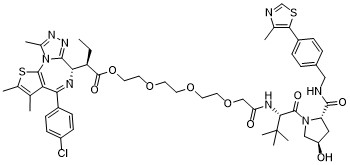| Cas No.: | 2776190-62-4 |
| Chemical Name: | AGB1 |
| Synonyms: | AGB1,AGB-1,AGB 1 |
| SMILES: | ClC1=CC=C(C=C1)C2=N[C@H](C3=NN=C(N3C4=C2C(C)=C(C)S4)C)[C@@H](CC)C(OCCOCCOCCOCC(N[C@@H](C(C)(C)C)C(N5C[C@H](O)C[C@H]5C(NCC6=CC=C(C=C6)C7=C(C)N=CS7)=O)=O)=O)=O |
| Formula: | C51H63ClN8O9S2 |
| M.Wt: | 1031.68 |
| Purity: | >97% |
| Sotrage: | 2 years -20°C Powder, 2 weeks 4°C in DMSO, 6 months -80°C in DMSO |
| Publication: | Bond AG, Craigon C, Chan KH, Testa A, Karapetsas A, Fasimoye R, Macartney T, Blow JJ, Alessi DR, Ciulli A. Development of BromoTag: A "Bump-and-Hole"-PROTAC System to Induce Potent, Rapid, and Selective Degradation of Tagged Target Proteins. J Med Chem. 2021 Oct 28;64(20):15477-15502. doi: 10.1021/acs.jmedchem.1c01532. Epub 2021 Oct 15. PMID: 34652918; PMCID: PMC8558867. |
| Description: | AGB1 is a fast, highly selective, and potent bump-and-hole (B&H)-PROTAC degrader for BromoTag. AGB1 exhibits degradation for Ab:Brd4BD2 L387A and Ab: BromoTag-Brd2 with pDC50s of 7.8 and 7.9. AGB1 exhibits binary affinity to VHL (Kd=125 nM). AGB1 exhibits favorable pharmacokinetic profile in mice with the DC50, 6 h of ∼13 nM. |
| References: | Bond AG, Craigon C, Chan KH, Testa A, Karapetsas A, Fasimoye R, Macartney T, Blow JJ, Alessi DR, Ciulli A. Development of BromoTag: A "Bump-and-Hole"-PROTAC System to Induce Potent, Rapid, and Selective Degradation of Tagged Target Proteins. J Med Chem. 2021 Oct 28;64(20):15477-15502. doi: 10.1021/acs.jmedchem.1c01532. Epub 2021 Oct 15. PMID: 34652918; PMCID: PMC8558867. |

 To enhance service speed and avoid tariff delays, we've opened a US warehouse. All US orders ship directly from our US facility.
To enhance service speed and avoid tariff delays, we've opened a US warehouse. All US orders ship directly from our US facility.




















